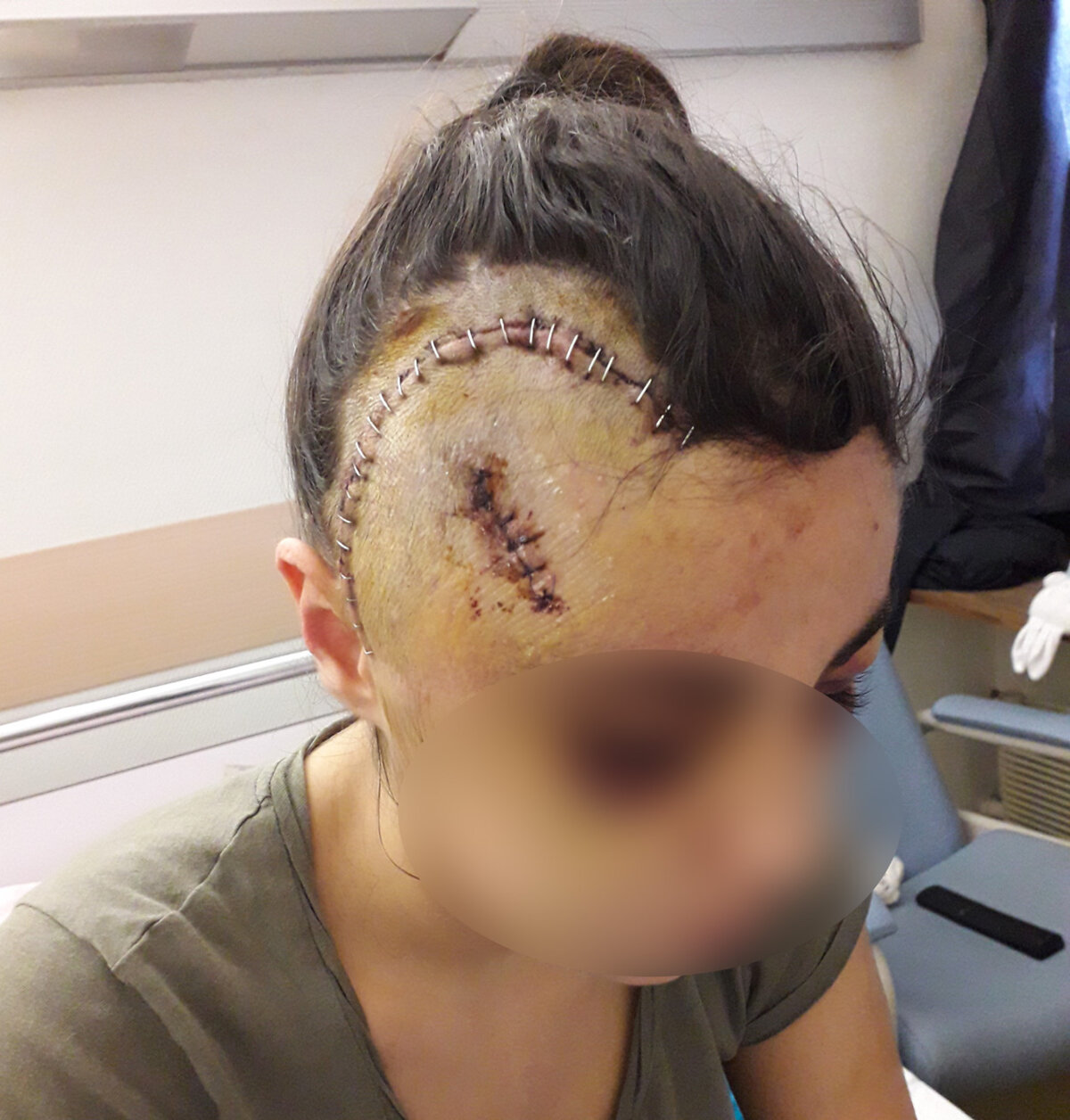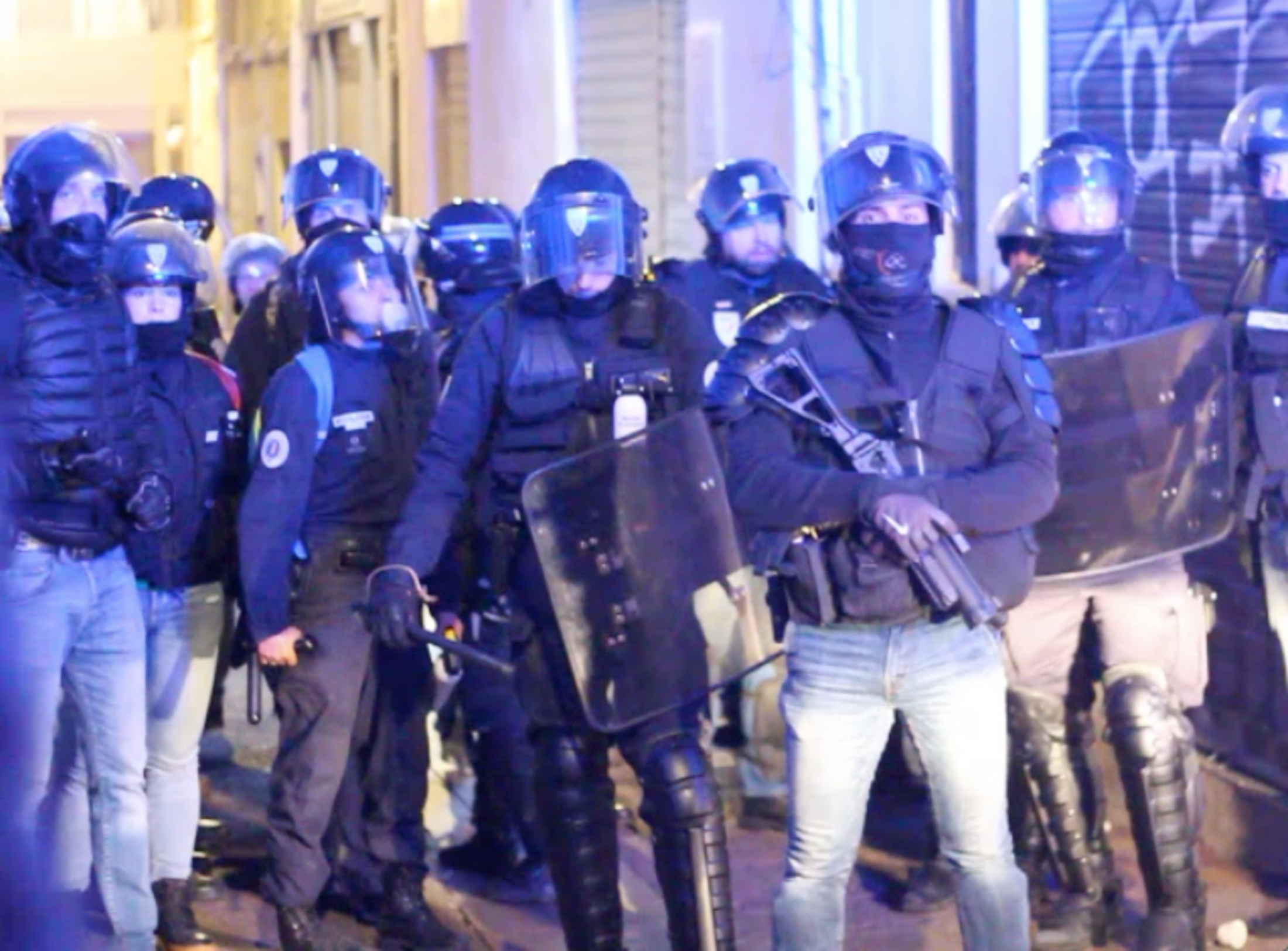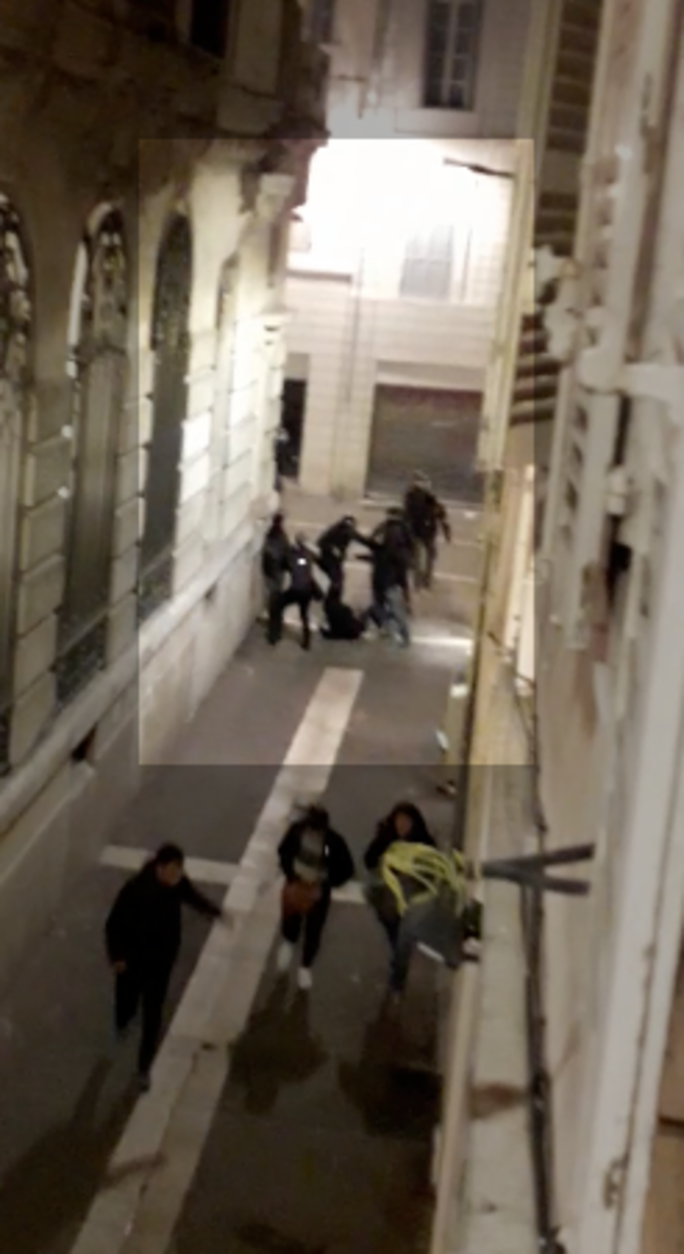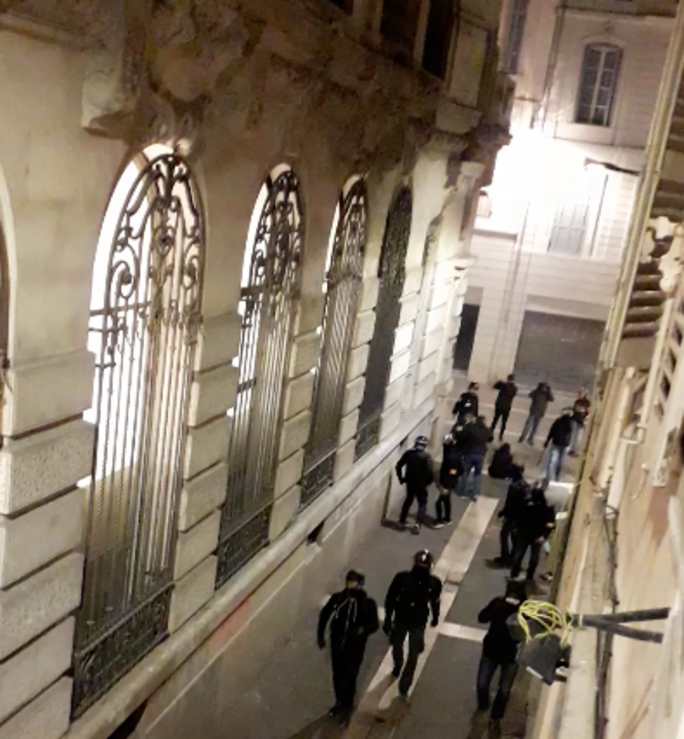On December 8th 2018 Maria* was seriously injured by police officers in Marseille in the south of France, according to witness accounts. Having already been hit in the thigh by a projectile fired from a non-lethal weapon, the 19-year-old woman, who had collapsed to the ground, was then savagely hit with batons and kicked in the head according to witnesses, medical reports and a complaint filed by her layers.
At hospital she had emergency surgery for “craniofacial trauma” to the right of the head caused by “a blow from a baton” and a “depressed skull fracture” to the front right of the skull consistent with “brain contusion”. Maria had a fractured skull and brain injuries. It was only in April this year, five months after the incident, that she was able to resume her work as a sales assistant, a job she alternates with her studies. She is still under medical supervision and is also consulting a psychiatrist about her “state of acute stress” linked to “frequent nightmares”, according to medical reports.
On Tuesday April 30th Maria's lawyer, Brice Grazzini, lodged a formal complaint with the prosecutors' office in Marseille against “unnamed persons, who have however been identified as exercising the function of a police officer” for “attempted murder”, “aggravated assault”, “ failure to assist a person in danger” and “not impeding the commission of an offence”.

Enlargement : Illustration 1

The events in question took place in Marseille on Saturday December 8th 2018. At around 6pm on that day Maria left the city centre shop where she works to meet her friend and then go home. The pair went along Rue Saint-Ferréol, the main shopping thoroughfare, where earlier in the day there had been clashes arising from the fourth weekend of protests by “yellow vest” protestors and also people demonstrating against poor housing conditions in Marseille. Not far from there, in the Canebière and the Vieux-Port areas of the city, confrontations were continuing between demonstrators and the forces of law and order who were locking down a perimeter in adjacent streets.
“I was with my friend and the police told us that they were creating a security perimeter. We then headed for my home,” Maria told Mediapart.
Six people present at the scene that day have given evidence relating to the official complaint made by Maria. Among them is a woman called Olivia who said that the afternoon's demonstrations “had just ended and some groups of CRS [riot police] and police officers were continuing to occupy the main streets by blocking access or [stopping anyone] passing through. Several people, of different ages, were walking along Rue Saint-Ferréol. None had threatening attitudes. Everyone was calm.”

Enlargement : Illustration 2

In the images seen by Mediapart, the street does appear to have been relatively calm. Some police officers were present, as well as a few youth, and firefighters were extinguishing rubbish bin fires.
“Suddenly a group of men, dressed in black and armed with batons, were running and shouting in my direction,” said Olivia in her statement. She noted: “I immediately identified them as members of the forces of law and order. My rapid reflex was to get out of the way by moving back against the wall of the nearby block of flats to avoid being smashed in the rush.”
These details were confirmed by another witness, Camille, who was also present during the police officers' sudden and unexplained charge. She stated: “Though several of us were walking calmly along Rue Saint-Ferréol, and there were no clashes going on around us, a line of CRS [officers] and officers from the BAC [editor's note, the Brigade Anti-Criminalité which tackles street crime and often works in the most sensitive districts] fired projectiles (I don't know what kind) and started to come towards us very quickly. Several of us ran towards the first street at right angles (Rue de la Glace) to protect ourselves. I heard a cry of pain and I saw someone, a girl, fall.”
The “girl” in question was Maria. “When the police charged I had no idea at all what was going on,” Maria told Mediapart. “I've never demonstrated and I was very afraid. I ran towards the first street at right angles, Rue de la Glace, but I was shot in my leg. I cried out because my leg hurt a lot. I fell to the ground.”
What happened next was chilling. Several accounts speak of an episode “full of violence”. Witness Laurence said that after they had seen Maria hit by the non-lethal projectile some people had “started to cry out 'someone on the ground!' At the same time this person on the ground was encircled by police and hit violently with batons even though she was on the ground... At the time I was in shock. The scene was full of violence. I saw batons savagely hitting the person continuously for quite some time.”
The witness Camille said that “more than ten police officers in jeans and wearing helmets, batons in hand and with armbands, came running up and each in turn kicked and hit the person trapped on the ground with their baton”.

Another witness contacted by Mediapart, Denise, still gets upset talking about the events of that evening. “Just ahead of me there was this slim girl who fell. And then a swarm of police officers, most of them in civilian clothes and wearing helmets, rushed into the little street and, as they passed, hit the girl with their baton and kicked her while she was on the ground”.
Denise is adamant about what she saw: “There were at least three blows from batons, and from three different police officers, and a kick in the face. Afterwards I was moved away by a police officer.”
She was not the only witness to be pushed back. Lucie, who was also there at the time, said: “Despite the fact that the police were forbidding me to go and see her I insisted and managed to get through. When I got to her I found other people around her who'd come to her rescue and I noticed that her head had been smashed and was bleeding. There were traces of blood on the ground, right up to the walls …..The plain-clothed police left without even checking on her condition.”
Another witness made the same observation. “By the time we approached all the police officers around the person on the ground had gone. We saw she was in a very worrying condition as she had an open wound to her head,” said the witness.
'I don't know if this complaint will come to anything'
Denise called the fire brigade - who in France often carry out first aid in emergencies - while a nurse tended to Maria. “The attack took place around 6.40pm. I say attack because there's no other word for it,” she said. “Several of us were around her because there were still some police officers further down the street and we were afraid that they'd do the same thing again.”
Maria herself still has problems in recounting what happened at that moment. “I remember that my leg hurt a lot when I fell to the ground,” she said. “Then everything went very fast. Some police officers suddenly appeared over me and I received several blows to the head and then I felt a sensation of heat. I was so shocked. The blows carried on. Then I felt myself losing consciousness when some people came to help me.”
None of the astonished witnesses at the scene can understand the reasons for the attack. Mediapart has meanwhile seen several videos of what took place that evening. One of them shows a person on the ground, surrounded by plain-clothed police officers, with armbands, with some people calling out to the officers: “Careful, stop it, she hasn't done anything! She fell, you arrived and you beat her.”

In another video several officers from the BAC can be seen striding along the street with one hitting their baton against the wall and bellowing out, while according to the person who recorded the scene another officer says “it's not over”.
Maria, meanwhile, admitted that earlier that evening she had “stupidly set off firecrackers on the ground. It's idiotic, I know. I'd bought them with my friend to use one evening at a football match. But if that was the problem I don't understand, because at the time no one said anything to us. The police charge must have taken place at least 15 minutes afterwards.”
“Is it justifiable to hit a girl so violently in the head when she's on the ground, and already injured by a flashball [editor's note, a form of non-lethal weapon used by the police]?” asks her lawyer Brice Grazzini. To ensure that action is taken over the police violence that evening the lawyer has chosen to make an official complaint for the serious charge of “attempted murder by a person acting under public authority”.
“The police officers are also guilty of 'failing to assist a person in danger' and, given that no one intervened to stop this violence, also of 'not impeding the commission of an offence',” he added.
The lawyer says that after his client informed the authorities of the incident the body that polices the police, the Inspection Générale de la Police Nationale (IGPN), has been aware of it and the case was refereed to it on December 19th 2018. “We're in April and [Maria] has still not been interviewed,” said Brice Grazzini, who fears they cannot rely on the IGPN to pursue the police officers, as it is itself a police body judging the actions of fellow officers. He has also informed the independent ombudsman, the Défenseur des Droits, of the incident.
Contacted by Mediapart the IGPN said it did not comment on cases being referred to it and on any subsequent actions. It instead referred to the official figures given by the minister of the interior, Christophe Castaner, who has stated that since the start of the 'yellow vest' protests in November 2018 some 220 investigations had been opened into police violence and referred to the IGPN. On April 26th Le Figaro, citing a judicial source, said 25 cases had already been closed.
Critics fear there are good grounds for wondering whether these investigations will lead anywhere. The state has so appeared reluctant to accept the facts of these cases, despite the number of victims and the amount of evidence that has been gathered. Prosecutors, meanwhile, seem to be falling in line with the state's view, despite the risk that they are in effect offering a guarantee of impunity to the forces of law and order.
The United Nations recently condemned France's approach to the policing of yellow vest' protests. Its human rights commissioner Michelle Bachelet, speaking at the UN Human Rights Council in Geneva last March, called for a “full investigation” into claims of the “excessive use of force” against protestors.
The French government itself insists that “at no moment are LBD [non-lethal weapons] used against demonstrators, even vociferous ones, if they are not committing physical violence, in particular violence directed against the forces of law and order or serious damage. But in that case they are no longer demonstrators but participants in an illegal and violent gathering.”
The government adds that the use of other methods, such as batons and tear gas, allows the police to keep a distance which “guarantees a maximum of security … by avoiding direct contact and the subsequent injuries”.
“I don't know if this complaint will come to anything,” says Maria. “My mother helped me to prepare my case and collected witness accounts while I was in hospital.,” she said, adding that on the evening of the incident itself she had not wanted to tell her mother what had happened. “She suffers from diabetes and I was afraid how she'd react. But in the emergency ward the nurse made me call her by telling me: 'If you die during the operation your family will have to be informed'.”
Maria is now suffering from memory lapses. However, she said: “I've recovered the sight in my right eye, that's something. There was blood inside it which has since been absorbed. I have the impression that my brain is taking time to rebuild itself but that's taking all my body's energy.” She added: “What worries me is that a baton blow can have irreversible effects.”
Her lawyer, Brice Grazzini, said he is dismayed with what he has observed during those of his cases which involve “police violence”. He said: “My clients' injuries are very serious and it is obvious that this is an illustration of the current trend in how the government handles demonstrations. When I defend people being prosecuted for violence the proceedings are fast and the people are convicted if they are guilty.”
“Here, everything's complicated,” he continued. “The complaints are difficult to lodge, the judicial procedures are slow or even non-existent, and the worst thing is to hear the appropriate authorities anticipating the results of an investigation by asserting that no unlawful violence has been committed by the police forces. When I see what is happening in Maria's case or the one involving Zineb Redouane [editor's note, an 80-year-old woman who died after being injured by a tear gas grenade as she closed the shutters of her fourth floor flat in Marseille], whose son I am representing, it's unacceptable. Even minors are targeted and badly assaulted.”
On the same evening that Maria was hurt, and in the same area, a 14-year-old boy was hit in the head by a projectile from a non-lethal weapon, even though he was not taking part in the demonstrations. He suffered trauma to the skull and a loss of consciousness, as well as a fracture and wound to the front part of the skull.
“You get the impression that the district was the playground for a horde of barbarians. But these people were police officers,” said lawyer Brice Grazzini.
-------------------------------------------------------------------------
- The French version of this article can be found here.
English version by Michael Streeter


